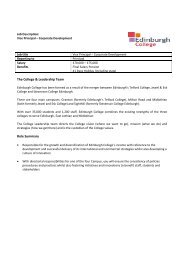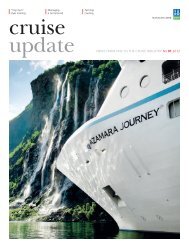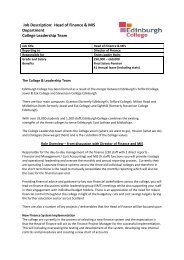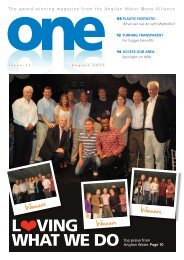update NewS from dNv to the tANker INduStry No 02 2011 - Hays
update NewS from dNv to the tANker INduStry No 02 2011 - Hays
update NewS from dNv to the tANker INduStry No 02 2011 - Hays
You also want an ePaper? Increase the reach of your titles
YUMPU automatically turns print PDFs into web optimized ePapers that Google loves.
RS Pla<strong>to</strong>u marketsShipping Weekly| RS Pla<strong>to</strong>u Markets*provides ship opera<strong>to</strong>rs with a means bywhich <strong>to</strong> efficiently prepare for vettinginspections and demonstrate a strongcommitment <strong>to</strong> safety and environmentalexcellence.On two of <strong>the</strong> days, <strong>the</strong> participantsattended Maritime Accident Investigationand Analysis sessions. Based on DNV’sM-Scat methodology (Marine SystematicCause Analysis Technique: effective accident/incidentinvestigation and followup),<strong>the</strong>se sessions offered a practicalapproach <strong>to</strong>wards incident investigationand analysis in <strong>the</strong> marine environment.The Tanker Week ended with a PracticalMarine Risk Assessment session. Participantswere introduced <strong>to</strong> risk managementterminology, principles and techniquesand, upon completion of <strong>the</strong> course, wereable <strong>to</strong> conduct risk assessments bothonshore and on-board.Participants commented that <strong>the</strong>y reallyenjoyed <strong>the</strong> training and would like DNV<strong>to</strong> organise similar events in <strong>the</strong> future.This feedback is very encouraging for <strong>the</strong>organisers, who will be organising a similarContainer week and Bulk Carrier week in2012.The sessions run during Tanker Weekwere based on general DNV courses availableworldwide in several DNV Academies.Please contact DNV Gdynia, your nearestDNV office or www.dnv.com <strong>to</strong> identify<strong>the</strong> most conveniently located DNV Academy.Anna Moen (Anna.Moen@dnv.com)will also respond <strong>to</strong> questions regardingTanker Week. alualuyuyalalellllyyuyaalyShipping WatchMyth-busters: Speed and earningsIn our June 23 rd weekly we compared <strong>the</strong> difference in speed for ~2,700 vessels travelling onFebruary 15 th and May 15 th <strong>2011</strong> <strong>to</strong> see if slow steaming had been implemented Data <strong>from</strong> RSPla<strong>to</strong>u Economic Research support our <strong>the</strong>sis that <strong>the</strong> combination of weak earnings and highbunker prices in fact has led <strong>to</strong> slow steaming, absorbing some of <strong>the</strong> over-capacity andlowering bunker expenses which consequently improve earnings for ship owners Equallyweighted, <strong>the</strong> average speed declined 2 3% <strong>from</strong> February <strong>to</strong> May and data <strong>from</strong> <strong>the</strong> samesurvey on August 15 th show that since May speed has been reduced by ano<strong>the</strong>r 2 4%, bringing<strong>the</strong> 6 month speed reduction <strong>to</strong> almost 5%16151413121114.514.013.0Speed in knots Feb-Aug <strong>2011</strong> Speed and Earnings change % Feb-Aug <strong>2011</strong>13.612.412.812.712.812.3 12.4 12.4Source: RS Pla<strong>to</strong>u Economic Research, RS Pla<strong>to</strong>u Markets12.711.815.915.8VLCC Suezmax Aframax Capesize Panamax Supramax LNG15-Feb 15-May 15-Aug BDIThe right hand chart shows development in earnings per day based on our speed assumptionsand speed reduction in percentage over <strong>the</strong> last 6 months based on <strong>the</strong> RS Pla<strong>to</strong>u EconomicResearch data. Findings <strong>from</strong> <strong>the</strong> survey show that VLCCs have reduced <strong>the</strong>ir average speedby ~7% <strong>to</strong> 13 knots currently at <strong>the</strong> same time as average earnings declined 72% <strong>from</strong>$42,300/day mid February <strong>to</strong> $11,900/day on August 15 th . The Suezmax segment shows <strong>the</strong>greatest speed reduction of ~9% <strong>to</strong> 12.4 knots as earnings are 35% lower <strong>to</strong> $10,700/day.Our earnings per day estimate include <strong>the</strong> assumption of lower speed and hence explain <strong>the</strong>difference <strong>to</strong> Baltic Exchange quotes for tankers suggesting that ship owners are subsidizing oilcompanies in order <strong>to</strong> transport <strong>the</strong>ir crude, not rational in our view. However, <strong>the</strong> BalticExchange assumes average speed of 14.5 knots, significantly below evidence <strong>from</strong> RS Pla<strong>to</strong>uEconomic Research indicating 13 knots average currently.Myth-busters: Does ship owners subsidize oil companies?At speed 14.5 knots as assumed by <strong>the</strong> Baltic Exchange, a VLCC consumes around 100 <strong>to</strong>ns offuel per day laden (with cargo) and 80 <strong>to</strong>ns on ballast (without cargo). Due <strong>to</strong> contractualspeed on <strong>the</strong> cargo transportation leg, slow steaming is mainly implemented on <strong>the</strong> ballast leg.Ship owners are able <strong>to</strong> reduce <strong>the</strong>ir daily bunker consumption <strong>to</strong> only 30 <strong>to</strong>ns by slowsteaming <strong>to</strong> ~11 knots on <strong>the</strong> return voyage. Hence, through reducing speed by 3.5 knots on<strong>the</strong> ballast leg ship owners are able <strong>to</strong> lower <strong>the</strong>ir average daily fuel consumption <strong>from</strong> 90 <strong>to</strong>nsat 14.5 knots <strong>to</strong> 65 <strong>to</strong>ns with slow steaming on <strong>the</strong> return voyage. Consequently, withunchanged bunker prices and rates <strong>the</strong> implementation of slower speed reduce fuel cost forship owners by almost 30%. 25 <strong>to</strong>ns per day with current Singapore bunker cost of $630/<strong>to</strong>ntranslate in<strong>to</strong> ~$16,000/day, which explain why ignoring slow steaming implies negativeearnings and willingness of ship owners <strong>to</strong> subsidize oil companies, both very irrational. Shipowners are paid in dollar per <strong>to</strong>n delivered. The Baltic assumption that a ship will return with<strong>the</strong> same speed and fuel consumption without cargo implies that <strong>the</strong> higher fuel consumptionwill be compensated through higher earnings over <strong>the</strong> extra days saved by increasing speed.However, current rates do not justify higher ballast bunker cost and consequently rationalreasoning and empirical evidence suggest that ballast bunker consumption is lower and hencealso earnings higher than <strong>the</strong> Baltic Exchange indicate. Never<strong>the</strong>less, with zero or negativeearnings we would see high laying up activity, which yet has not occurred with magnitudeindicating that ship owners find it more profitable <strong>to</strong> keep ships in traffic.We believe <strong>the</strong> myth of negative earnings for tankers are wrong. Rational reasoningsuggests slow steaming <strong>to</strong> lower fuel cost, supported by empirical evidence. Hence,we stand by our earnings forecasts which include lower speed and explain whylimited lay-ups have occurred.* Printed with <strong>the</strong> permission of RS Pla<strong>to</strong>u Markets..Earnings change in %80%40%0%-40%-80%-6.9%-72%-35%-8.7%Earnings change60%53%-3.9%-2.4%-15%-3.4%Speed change8%-7.0%38%-1.1%5%9%6%3%0%-3%-6%-9%Tanker <strong>update</strong> NO. 2 <strong>2011</strong> | 29
















